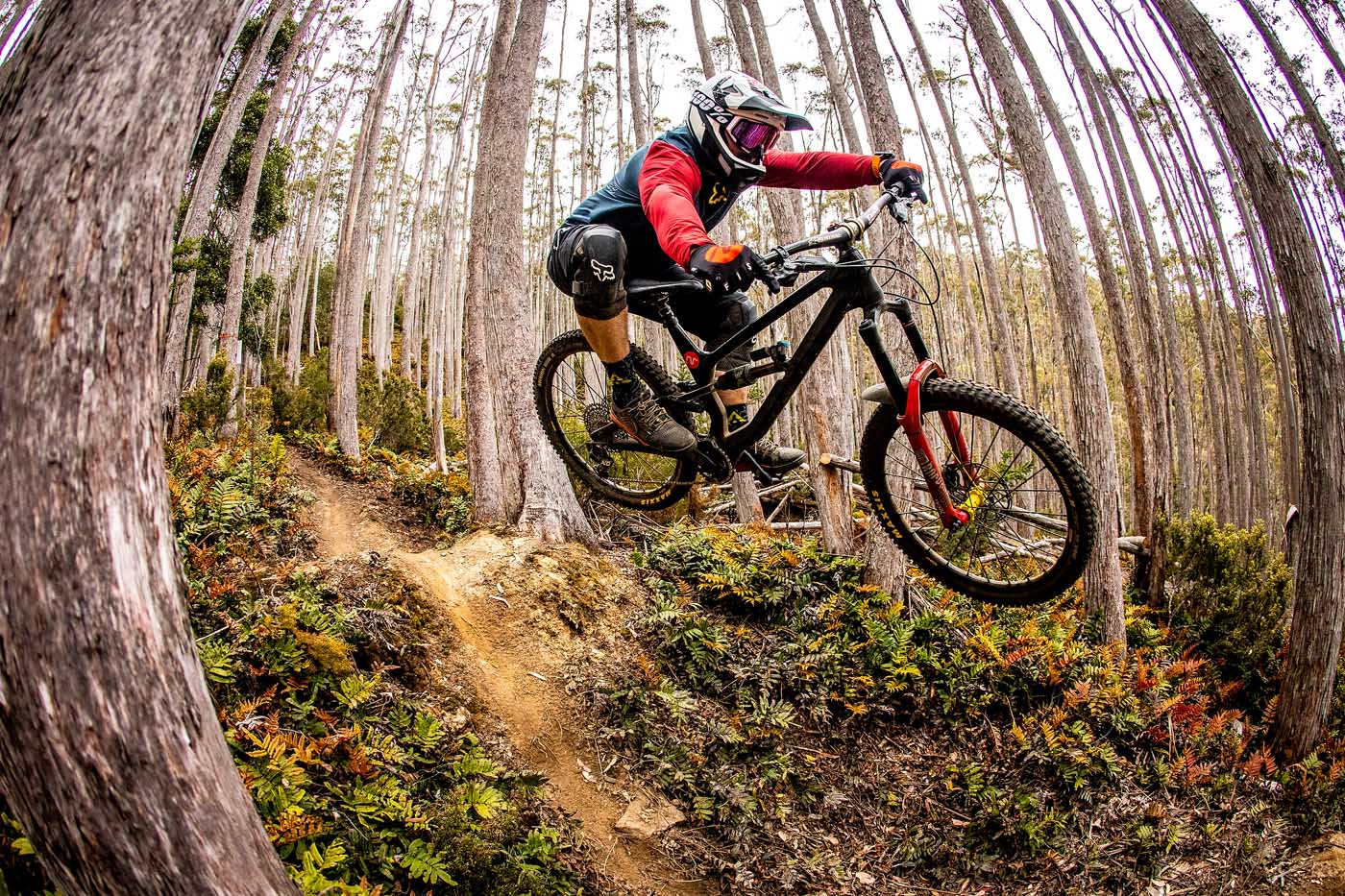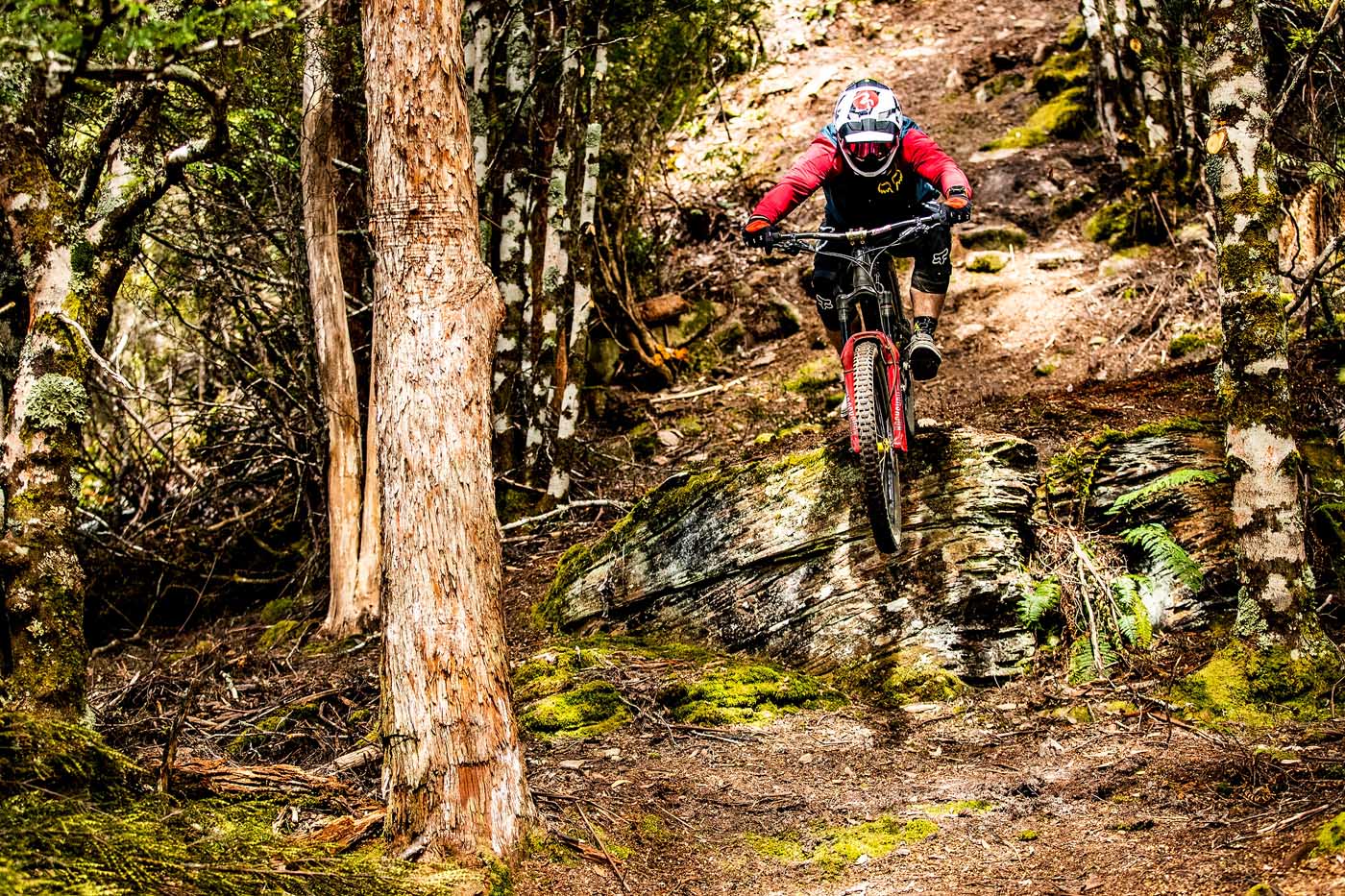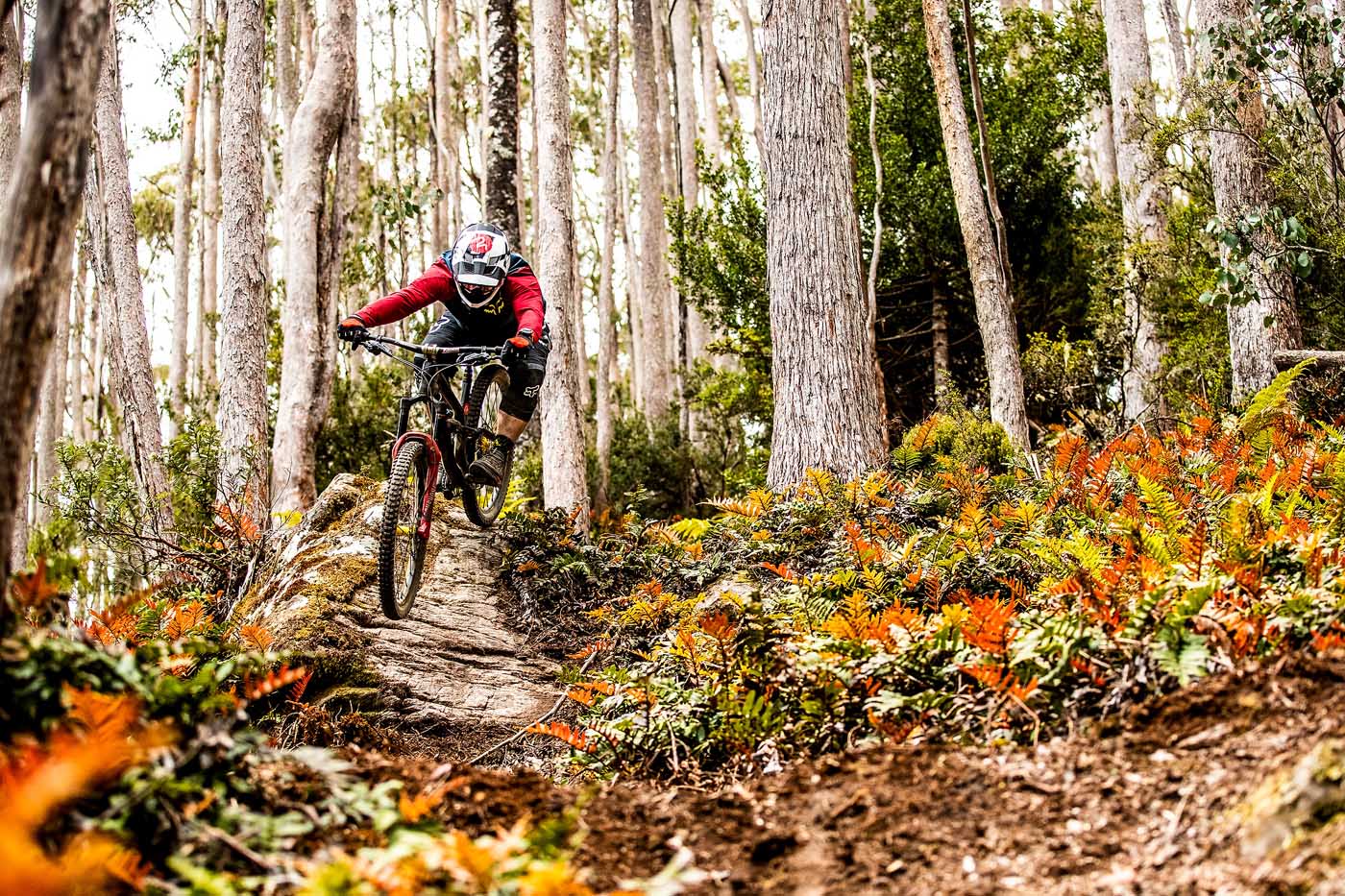I’ve known Frenchie for coming up to 20 years now and I’ve always been an avid follower of the endless list of ambitious projects and constant successes that have formed the week-to-week landscape of Simon’s career to date.
Words // JT Photos // Sven Martin
Recently we were chatting over a beer, having just done a couple of runs together down at his mega Maydena Bike Park, and he was telling me about some of the plans that he is currently working on for future. I remember sitting there thinking to myself, ‘this guy is a straight up visionary!’ Where does one even come up with the idea of setting out to create their own Whistler bike park right here in Australia? And then more to the point, how could anyone then have the balls to attempt to turn the idea into a reality? This guy, thats who. Of course however, Simon’s journey to this point hasn’t been without its fair share of good ‘ol blood, sweat and tears, sacrifices and steep learning curves. As you’re about to discover over the next couple of pages, Simon is a super passionate and highly driven individual. At the age of just 35 he has already built himself a mountain bike empire. But if you ask him, he’s still far from done yet!
A lot of people reading this are probably familiar with your name ‘now’ but perhaps, probably, at least a portion of them might not be aware of the journey that you traveled throughout the MTB world leading up to the point where you’ve ultimately built an empire created many of Australia’s biggest trail centres. And not to mention also building Australia’s biggest bike park, you actually started your MTB career as a rider and you raced for Australia on the Jr National DH team?
Correct! I raced junior downhill way back in the day, winning the Sub Junior National Champs in 2000 and racing Junior World’s in 2001- the year Been Cory won in Colorado.
You came through the DH ranks in the same year as Sam and Cory and Hannah didn’t you mate? Clearly you had your work cut out for you to try and make a name for yourself with the field as stacked as that.
That’s it, I grew up racing and hanging out with those guys and we’re all still good mates now. I loved racing but ultimately it wasn’t what I wanted to do with my life (the competition was pretty tough too!). It was a great time to race though, I think things were a lot more laid back. It’d probably be safe to say that most of us weren’t training as hard as the juniors are now.
Born and raised in Tassy, tell us a bit about the local riding scene down there throughout your teens and twenties?
The racing scene in Tasmania has always been small but strong. We had a lively racing scene through the 90’s and early 2000’s, all ran on informally built trails across the state. There was a crew of older riders back then who were ultra supportive of us juniors, such as Steve Price and Mark Leis, who helped out taking me to mainland races when I was younger. We hosted our first national series round back in 2005 in Glenorchy, and hosted several more years at the venue. I was heavily involved in the course and event management for these events, which was great fun and an excellent learning experience for me.
At what point along the way did you decide that you wanted to start making a difference to the local scene, more so than just being a rider within it?
I began building trails locally at around 11 years old, and always had a passion for it. I was heavily involved in getting Glenorchy MTB Park off the ground along with Luke Chiu and others back in around 2004, which definitely got me interested in helping develop more formalised riding in Tasmania. Around 2006 I put a proposal in to Clarence City Council to develop a formalised network of trails in the Meehan Range near Hobart, which went on to be developed by professionals and volunteers as the Clarence MTB Park, which is probably the busiest network of trails in the state.
Tell us about how Dirt Art first got started?
Dirt Art kicked off formally in 2008, but I had done some paid trail work and consulting as a sole trader prior to that. My first paid gig was a trail audit of my local informal jump trails, where I basically set up insurances and a basic business so that I could help save the trails from the bulldozer (which we did and the trails are still there to this day). At that point in time I had absolutely zero plans of trying to forge a career developing trails. In 2008 when Dirt Art was formed, some larger contracts were coming out and it seemed like a good time to make a bit more of a go at things, but I still had no real plans to work in the industry full time. It was another 4 years of simultaneously working what had become two full time jobs that I decided to resign as a nurse and pursue trail building full time. At the time there were many people in my life (particularly my mum!) who thought I was pretty crazy, and there’s certainly been times over the past 10 years that I’ve agreed with them, but I wouldn’t change that decision for the world.
Was it a steep learning curve for you through those earlier years as the business began to grow?
It was actually pretty simple running a small business with a single trail crew to begin with. At that point I was doing everything, but the business was pretty simple. Growing a business is extremely hard, and the contract environment we work in means you never really know for sure what work you’ll have coming up. There was definitely a steep learning curve learning the ‘back end’ of running a business, and recruiting and managing staff. We are a team of over 50 now and I have an awesome management team in place, which generally gives me the freedom to focus on the things I’m good at.
Before Maydena came along what are some of your proudest moments and Dirt Art built projects that you are most happy with how they turned out?
We’ve delivered some amazing projects over the years, but a few definitely stand out. I’ll always be proud of the work we have done at Thredbo, developing trails in the alpine environment is extremely challenging and requires a huge amount of work in planning, approvals and tightly-managed construction. The All Mountain trail we built at Thredbo is the highest elevation trail in the country and the only alpine mountain biker trail in NSW, and getting it built was a huge achievement for our team and all the guys at Thredbo Resort. The other project that springs to mind is the Hero Trail in Bright. The project was the first time in Australia a large-scale jump/flow trail had been built in a public setting. There were so many challenges getting this project planed and built, but I’ll always be proud of the positive impact that the trail had on the trail scene in Australia.
Am I right in thinking that you guys are the only Australian based trail building company that has won contracts to build trails overseas as well?
We’ve built trails in China and New Zealand, and have some other stuff coming up in other locations. I know a couple of other Australian trail builders have done some work overseas.
Pretty much every State government in Oz right now seem excited about MTB access and funding stacks of new trail networks. As someone with so much experience in working with government and regional bodies to bringing trails to life through your business, could you perhaps give us a quick overview of how the whole tender process works for a trail builder company to come along and pitch their plans, have it approved and then start digging trails?
We get involved in projects at a variety of stages, often during their early feasibility and concept stage, but sometimes just before the construction stage. The majority of our projects are won through government tendering, but many commercial operators just engage us directly. Tendering is always different, but essentially it involves being given a scope and project brief and being asked to prepare a bid and pricing to deliver the project. We don’t get paid to tender for projects and have no guarantee of winning work, so often all the work you put into a tender amounts to nothing. Tendering takes significant time and resources; some of our bigger tenders have involved several hundred hours of staff time, travel costs to site, and have been 20,000+ word response documents. It’s a pretty tough industry, but it’s how public project procurement works.
Which brings us to Maydena… I’m sure a lot of people reading this have laid in bed at night having crazy ideas like building their own mega bike park, but you turned that dream into a very large reality and essentially went out and bought the best part of an entire mountain and half the bloody town below it in order to literally build a mega bike park! Where do we even begin? I guess tell us a bit about how the whole crazy idea of yours came to fruition?
Wow, where to start! In a nut shell, I was invited out to Maydena back in 2008 by Forestry Tasmania, who had invested around $5m in an amazing summit building and other infrastructure, and planned to install a gondola to the top. For a range of reasons the project was abandoned partially completed. They were wanting us to plan a major mountain bike destination there to recover the project. At the time the planets didn’t align and the project was abandoned completely, and a few years later the site was handed over to Parks and Wildlife. In 2015 the state government launched a process inviting commercial operators to submit proposals for developing tourism operations in Parks-managed areas, which gave us an avenue to prepare a proposal to take over a lease of the site. Our project was really complicated, involving several different land tenures, including the bulk of the site being World Heritage Area. After two long and expensive years of negotiating and planning, we achieved a lease agreement on the site and formal planning work was kicked off. It took us three separate development applications, and multiple other approval processes before we gained full approval to commence construction. The approvals process took 6 months longer than we’d hoped and cost around twice what we’d initially expected, with the result being that we had just 7 months to build a bike park. We pulled together an amazing construction team, and managed to deliver a pretty special 35km network of trails in time for the park’s opening, January 26th 2018. Despite having quite a bit of investor interest, I decided to do it the hard way, bootstrapping the project so that I could retain 100% ownership and control over every decision we made. I wanted to be able to make the best decisions, not the decisions that would make us profitable straight away, and I knew we’d be unlikely to be able to do that with investors on board.
The whole process has been a huge roller coaster ride, full of never ending challenges, but every day I’m out there seeing people enjoy the trails, I’m reminded that it was all definitely worth it! Going forward we are working towards completing our first 100km trail development stage in the early part of 2019, and have already begun planning the next phase of the development at the park.
Oh come on, don’t leave us hanging without at least a teaser of info about what ‘phase 2’ will entail?
We are still finalising the phase two plans, and aim to get the approvals for these moving in the first quarter of 2019 so we can be underway next summer. I can say though that we are looking at building some more back country descending trail rides, a huge skills park, and a heap more trail, including a bunch more trail riding and gravity trails. Beyond trails, we’re developing a new restaurant at our base building, a new car park, and permanent bike wash facility.
Our goal is to develop a bike park that provides riders with a trail experience that rivals anything else in the world, but also to develop our other facilities and the town itself as an awesome place to holiday with your bike.
The bike park has been breathing a whole new lease of life back into the town of Maydena. Within the bike park itself you’ve got an awesome bar, cafe, a bike shop covering retail sales, bike hire and mechanics. Have other new businesses sprung up in town since the bike park opened to cater for the new wave of daily visitors?
We haven’t even been open a year yet, but there has already been a fair bit of movement in the business and investment space. Around 30 properties have sold in the town, the majority of which have been converted to Air BnB accommodation, and a number of companies are now transporting riders between Hobart and/or Blue Derby and Maydena. We didn’t want to wait for the business sector to respond, and we wanted to make sure our riders had everything they needed, so we tick a lot of the boxes for riders needs, which is obviously a challenge for other operators (particularly in the food and beverage space). I do think though that as we move into next summer (19/20) we’ll start seeing some bigger investment into restaurants and related businesses as our numbers continue to grow.
Have you considered even building your own accommodation for riders at some point in the future?
We definitely have, and I have some land options that would work for it. It hasn’t been something I’ve had the resources or time to pursue just yet, but I wouldn’t say never. If accommodation starts becoming a major blocker for growing our visitor numbers then we will step in and do something in the space, but my hope is that someone else with experience and passion in that space will step in. We know from rider feedback that there is a real demand for a camp ground, which we may look at if no one else fills the space.
The bike park is getting set to host some massive races in future, including National Champs amongst others. Tell us a bit about some of the events that you’ve got in the pipe line?
We are stoked to be hosting the 2019 MTBA National Enduro Champs in 2019, and have definitely got our eyes on a few more major national and international events. We will be building our World-level DH trail soon, which will open us up to a whole host of other events. In terms of our own in-house events, our strategy is to host one major enduro and gravity festival (2 events) each year. Gravity Fest this year will go down January 24-27 (www.gravityfest.com.au), and Enduro Fest is set for the weekend of April 5-6 (www.endurofest.com.au). The other events we are looking at are a marathon XC race and potentially an off road muti-sport event.
Clearly you’re a guy that has dreamed big and created a huge amount (of trails and) success up to this point in your career. Can I ask what’s the plan/goal list for say the next years of Simon French’s life?
I’m not the kind of person who likes sitting still, so I definitely have a few things planned over coming years to keep me and our teams busy! We are full steam ahead with our trail development company, Dirt Art (www.dirtart.com.au), developing both public and commercial mountain bike facilities across Australia and around the world. We have also recently launched a walking trail company, Dirt Art Walks (www.dirtartwalks.com.au), developing large-scale multi-day walking trails such as the Grampians Peaks Trail in Victoria. We are also currently working on a major proposal for a multi-day walk at Maydena in a similar style to the Three Capes Track, which is part of our plan to diversify Maydena into a bigger adventure destination beyond just mountain biking.
In terms of bike and adventure parks, we have another commercial mountain bike operation planned in Tasmania that should be under construction later this year all being well (we are working through the approvals as we speak). We are also exploring options to develop two more of our own commercial bike parks across Australia.
On the personal front I just want to keep having fun, developing things that bring people happiness in the outdoors, whether that be on a bike, walking or otherwise. I take huge satisfaction in taking big ideas and turning them into a reality, so I have every intention of keeping on doing that for as long as I possibly can.
‘Here-here’ to that Frenchie! Keep up the amazing work mate. Cheers for the chat.








